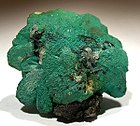Linarite
Today we want to delve deeper into the topic of Linarite, a topic that has gained relevance in recent years and that undoubtedly generates great interest among the population. Linarite is a topic that covers multiple aspects and has been the subject of constant debate and analysis. In this article, we will explore different perspectives and approaches related to Linarite, with the aim of providing a comprehensive view on this topic. From its origins to its impact today, Linarite has captured the attention of academics, experts and the general public, being the object of study and interest in various areas. Without a doubt, Linarite has become a relevant topic in contemporary society, which is why it is essential to deepen its understanding and scope.

| Linarite | |
|---|---|
 | |
| General | |
| Category | Sulfate minerals |
| Formula (repeating unit) | PbCu |
| IMA symbol | Lna |
| Strunz classification | 7.BC.65 |
| Crystal system | Monoclinic |
| Crystal class | Prismatic (2/m) (same H-M symbol) |
| Space group | P21/m |
| Unit cell | a = 9.701(2), b = 5.65 c = 4.69 ; β = 102.65°; Z = 2 |
| Identification | |
| Color | Deep azure blue |
| Crystal habit | Crystals elongated and tabular; in crusts and aggregates |
| Twinning | Common on {100}, also on {001} |
| Cleavage | Perfect on {100}, imperfect on {001} |
| Fracture | Conchoidal |
| Mohs scale hardness | 2.5 |
| Luster | Sub-adamantine, vitreous |
| Streak | Pale blue |
| Diaphaneity | Transparent, translucent |
| Specific gravity | 5.3 – 5.5 |
| Optical properties | Biaxial (−) |
| Refractive index | nα = 1.809 nβ = 1.838 nγ = 1.859 |
| Birefringence | δ = 0.050 |
| Pleochroism | X = pale blue; Y = blue; Z = Prussian blue |
| 2V angle | Measured: 80° |
| References | |
Linarite is a somewhat rare, crystalline mineral that is known among mineral collectors for its unusually intense, pure blue color. It is formed by the oxidation of galena and chalcopyrite and other copper sulfides. It is a combined copper lead sulfate hydroxide with formula PbCuSO4(OH)2. Linarite occurs as monoclinic prismatic to tabular crystals and irregular masses. It is easily confused with azurite, but does not react with dilute hydrochloric acid as azurite does. It has a Mohs hardness of 2.5 and a specific gravity of 5.3 – 5.5.
Linarite was first identified in 1822. It is named after the Linares Plateau, Spain. It occurs in association with brochantite, anglesite, caledonite, leadhillite, cerussite, malachite and hemimorphite.
Gallery
-
A shallow pocket of crystals of an intense cobalt blue, from Darwin, Darwin District, Inyo County, California, US
-
Linarite with malachite, Blanchard Mine, Hansonburg District, Socorro County, New Mexico US (Size: 1.1 × 0.8 × 0.4 cm)
-
Linarite with caledonite, from Baker, El Dorado County, California US (Size 5.4 × 5.2 × 3.2 cm)
-
Unusual cerussite with a coating ingrained into the surface of microcrystalline malachite and linarite that give it a rich blue-green color
References
- ^ Warr, L.N. (2021). "IMA–CNMNC approved mineral symbols". Mineralogical Magazine. 85 (3): 291–320. Bibcode:2021MinM...85..291W. doi:10.1180/mgm.2021.43. S2CID 235729616.
- ^ a b Linarite, Mindat.org, retrieved 11 July 2022
- ^ Barthelmy, David (2014). "Linarite Mineral Data". Webmineral.com. Retrieved 27 June 2022.
- ^ a b Anthony, John W.; Bideaux, Richard A.; Bladh, Kenneth W.; Nichols, Monte C. (2005). "Linarite" (PDF). Handbook of Mineralogy. Mineral Data Publishing. Retrieved 11 July 2022.
Wikimedia Commons has media related to Linarite.



